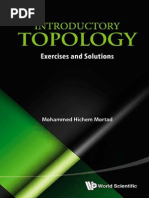Basic Topology Armstrong Pdf

In this broad introduction to topology, the author searches for topological invariants of spaces, together with techniques for calculating them. Students with knowledge of real analysis, elementary group theory, and linear algebra will quickly become familiar with a wide variety of techniques and applications involving point-set, geometric, and algebraic topology. Over 139 In this broad introduction to topology, the author searches for topological invariants of spaces, together with techniques for calculating them. Students with knowledge of real analysis, elementary group theory, and linear algebra will quickly become familiar with a wide variety of techniques and applications involving point-set, geometric, and algebraic topology. Over 139 illustrations and more than 350 problems of various difficulties will help students gain a rounded understanding of the subject. The title to this book is awfully deceptive. While the material it cover's is indeed 'Basic Topology', the book makes it anything but 'Basic'.

There are errors in the text and the homework problems are ridiculously challenging for a book which is supposed to be a 'first exposure' on the subject. In fact, the title of the book can be questioned as to whether or not the content is truly 'basic'.
Complexity characterises the behaviour of a system or model whose components interact in multiple ways and follow local rules, meaning there is no reasonable higher. Armstrong: Basic Topology. Armstrong: Groups and Symmetry. Axler: Linear Algebra Done Right. Second edition. Beardon: Limits: A New Approach to. Real Analysis. Ba~ewman: Complex Analysis. Second edition. Banchowermer: Linear Algebra. Through Geometry. Secofid edition. Berberian: A First Course in Real. Undergraduate Texts in Mathematics. Apostol: Introduction to Analytic. Number Theory. Xii, 338 pages. Armstrong: Basic Topology. Xii, 260 pages. Halt/Newman: Complex Analysis. X, 224 pages. Banchoff/Wermer: Linear Algebra. Through Geometry. X, 257 pages.
In addition to covering the fundamental group and the classification of covering spaces, the book also The title to this book is awfully deceptive. While the material it cover's is indeed 'Basic Topology', the book makes it anything but 'Basic'. There are errors in the text and the homework problems are ridiculously challenging for a book which is supposed to be a 'first exposure' on the subject.
In fact, the title of the book can be questioned as to whether or not the content is truly 'basic'. In addition to covering the fundamental group and the classification of covering spaces, the book also covers basic homology theory which more advanced books such as Munkres and Massey's Algebraic topology leave out. While the author only restricts his attention to the more basic case of simplicial homology, some of the power and elegance is lost without presenting the more general and powerful theory of singular homology. In my opinion, it is a mistake to present homology theory without covering exact sequences and excision (as the reader is left to feel that the computation of such invariants is very ad-hoc and 'messy').
The author is a typical geometrical mathematicians who is really good at intuitive imagination. However, I am not so sensitive to geometry but prefer analysis and algebra. So when I saw another classical textbook by Munkres, I thought that may be better for learners who lack strong intuitive imagination about geometry.
Cork Report 1982 Pdf Files. Even though, this is a great topological textbooks for undergraduate mathematical students, I personally suggest that readers enforce the intuitive imagination about geometry might The author is a typical geometrical mathematicians who is really good at intuitive imagination. However, I am not so sensitive to geometry but prefer analysis and algebra. So when I saw another classical textbook by Munkres, I thought that may be better for learners who lack strong intuitive imagination about geometry.
Even though, this is a great topological textbooks for undergraduate mathematical students, I personally suggest that readers enforce the intuitive imagination about geometry might find it helpful to review the first chapter after finishing the whole book.
Comments are closed.